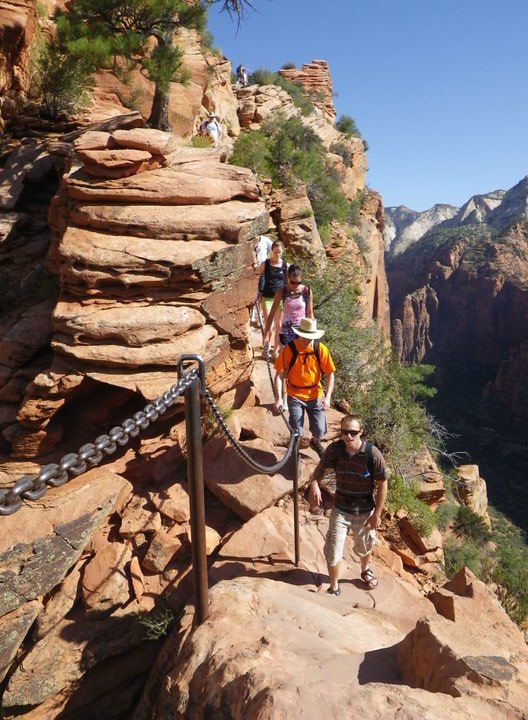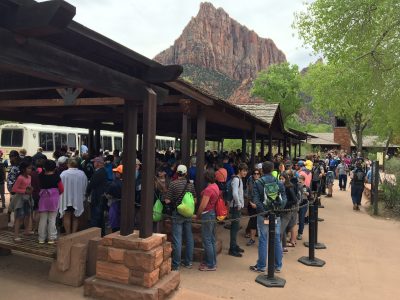
ST. GEORGE — Limited parking, long shuttle lines and crowded trails are what visitors have come to expect as the number of people going to Zion National Park has continued to rise for years, but while visitation has increased by millions in the past decade, the park saw a decrease in visitation last year for the first time since 2013.
Having reached a whopping 4.5 million visitors in 2017, 2018 saw 184,779 fewer visitors than the year before, bringing the total number of visitors down to 4.3 million, which is still a little bit more than the park saw in 2016.
“They’re still up from just a couple years ago, so they haven’t dropped significantly,” Zion spokeswoman Aly Baltrus said. “I don’t know that we can read anything into it. … We can’t call it a trend yet.”
The numbers may be down, but they’re not down enough to significantly affect park operations. The large number of visitors still impacted park resources and infrastructure last year, and even though they tried to plan to accommodate 4.5 million visitors, they still saw long shuttle lines and went through large amounts of supplies like toilet paper and brochures.
“It’s actually just making planning almost a little harder because we don’t know as much what to expect,” Baltrus said. “But at the same time, it’s definitely helpful to have the lines not quite so long, people not quite so angry, and hopefully more people are having more of a park service experience with a little less congestion.”
It’s hard to say exactly why visitation was down last year, Baltrus said. It could have had something to do with weather conditions or a growing reputation for being overcrowded. But perhaps the more likely reason has to do with the large number of closures that the park experienced throughout the year.
Angels Landing, one of the park’s most popular hikes, was closed for two months after an intense storm caused major flooding and damaged a portion of the West Rim Trail on July 11. The same storm caused significant damage to the Kayenta Trail, closing off access to the Upper Emerald Pools Trail, which remains inaccessible.

The Hidden Canyon Trail closed three times over the summer, and an active rockfall has kept the trail closed since Aug. 28. The popular – and more easily accessible to your average visitor – Middle Emerald Pools Trail and the terminus of Lower Emerald Pools Trail are also currently closed.
The biggest closure was the Kolob Canyons district, which was shut down for nine months after roadwork began in May. Kolob brings in around 85,000 of the park’s visitors each year, accounting for almost half of the 184,779 visitor decrease.
“If Kolob Canyons had been open, we would have been about the same as the year before, so about 4.5 million,” Baltrus said. “With Kolob Canyons being closed it wasn’t really 4.5, but we had the same basic visitation in the main canyon.”
However, while some wondered if visitation to the park would go down during the 35-day partial government shutdown that ran from the end of 2018 into the beginning of 2019, numbers were actually up during this time – possibly as a result of no park entrance fees being collected. The park reached a record-high number of visitors over the Christmas holiday, with around 35 percent more visitors than officials had projected based on the numbers from 2017.
Read more: Surviving the shutdown; How Zion and its park rangers are making do
However, the number of visitors that were in the park during the shutdown is an estimate since a limited number of staff were allowed to work during that time. Car counters at both entrances recorded the number of vehicles that entered the park, allowing them to estimate the number of people.
But even though visitor numbers were up during the shutdown, numbers as a whole were down during December 2018 and January 2019, which Baltrus attributes to an increase in winter storms.
“We had a lot more weather this year than we had last year. … We had a lot of snow and ice and things like that that we didn’t have the year before.”

Discussion in the media about Zion’s overcrowded conditions may have also discouraged some people from visiting the park in 2018, Vicki Varela, managing director of the Utah Office of Tourism, said.
“There’s been a lot of discussion about how Zion is managing the huge crowds and the possibility of different scenarios for managing the crowds,” Varela said. “Sometimes people read about that and they’re either scared away by the crowded conditions, or they make assumptions that there have been constraints put on visitation that don’t really exist.”
This discussion around Zion’s overcrowding may be part of the reason why other parks, such as Bryce Canyon National Park, which does not have the same reputation for being overcrowded, saw an increase in visitation while Zion’s decreased.
It may also have to do with the efforts by the Utah Office of Tourism in recent years to get tourists to visit other attractions in Southern Utah and to come during the off-season.
“We’ve been really marketing to people to have other experiences in the region. Yes, maybe they spent a day or a half a day at Zion National Park. But we’re encouraging them to get out and explore all the other wonders of Southern Utah,” Varela said. “So we feel some confidence that people are responding to that message.”
The efforts appear to be having some success, Varela said, because while Zion’s visitor numbers are down, most of the other national parks in the state have seen an increase. Bryce Canyon, Arches and Capitol Reef all saw an increase in visitation for 2018. Canyonlands visitation was down a little bit as well, but Varela attributes that to the fact that it has always been one of the less popular Utah parks.
Additionally, while Zion’s numbers were down a bit for the most part during the spring and summer months, the number of visitors coming during winter months actually increased. Nearly 20,000 more visitors came to Zion in January 2018 than in 2017, and over 17,000 more in February.

The Utah Office of Tourism does not, however, want to decrease visitation at the cost of hurting local businesses, which is why they’ve adopted the Utah Tourism Red Emerald initiative. Part of the initiative is to focus on attracting the right kinds of visitors, the ones that stay longer, spend more money, get off the beaten path and keep coming back.
This strategy appears to be working, Varela said, because while Zion’s 2018 visitation was down by 4.1 percent, the transient room tax collections for the county were up by 9.7 percent, meaning that hotels in the area did better than the year before despite visitation being down.
Breck Dockstader, owner of Cliffrose Lodge and Gardens, Springdale Visitor Center and several other vacation rental companies and restaurants in Springdale, as well as a board member of the Utah Tourism Industry Association and the Zion Canyon Visitors Bureau, has noticed an increase in revenue, especially during peak season.
Cliffrose was closed for much of 2018 for renovations, but in the months that it was open, its average daily rate was up by $50 per night. And the Springdale Visitor Center saw an 18 percent year-over-year increase in revenue from 2017 to 2018. And even compared to 2018, their rates have been up substantially so far this year.
“This aligns with the Utah Office of Tourism’s Red Emerald initiative to focus on quality, not quantity. We are seeing this effort really gain traction,” Dockstader said. “I think with strategic marketing and the right strategies we can continue to change the way people visit Zion so that they have an incredible experience while being here.”
Email: [email protected]
Twitter: @STGnews | @MikaylaShoup
Copyright St. George News, SaintGeorgeUtah.com LLC, 2019, all rights reserved.